Introduction
Cells in Your Body
Cells are the tiny building blocks that make up all living things. There are many different kinds of cells in your body that do many different things needed to keep your body alive and running smoothly.
Because the cells in your body do different things, they look very different from each other and come in many different sizes and shapes. Some are long and thin, while others are small and compact. Some have special projections on their surface to do specific tasks, like absorbing nutrients or communicating with other cells.
You've probably seen photos or drawings of cells in biology textbooks. You might have even seen real cells under a microscope before. But, it's less common to see images of many different types of cells together in one image. So, it can be difficult to understand how big one cell type is compared to another. In the Compare Cells section, we'll take a look at some common cell types in the human body and how their sizes compare.
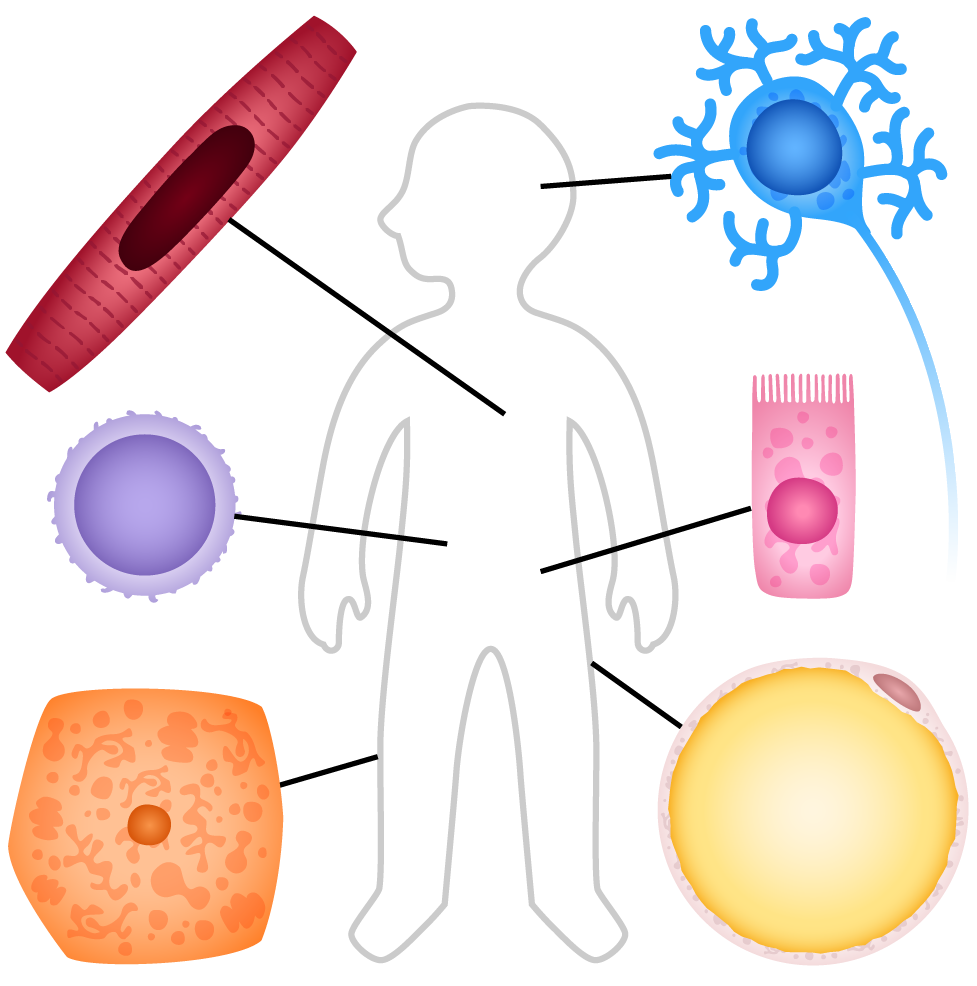
Scale
Cells are tiny! They're so small that you need powerful microscopes to be able to see them. To measure the size of cells and other really tiny things, scientists use microns (also known as micrometers). The abbreviation for micron is μm. A micron is one millionth of a meter (10-6 meters).

The Nucleus
The nucleus is the control center of the cell. It's where cells store all their genetic information (DNA), which gives the cells instructions on how to behave and function. Most cells have only one nuclei, but some cell types have many nuclei, while others have none.
The size of the nucleus inside the cell is different for different cell types. One way to describe how big the nucleus is compared to the overall cell is with the nuclear to cell size ratio (NC ratio for short).
You can calculate the NC ratio using the following formula:
Nucleus volume / cell volume = NC ratio
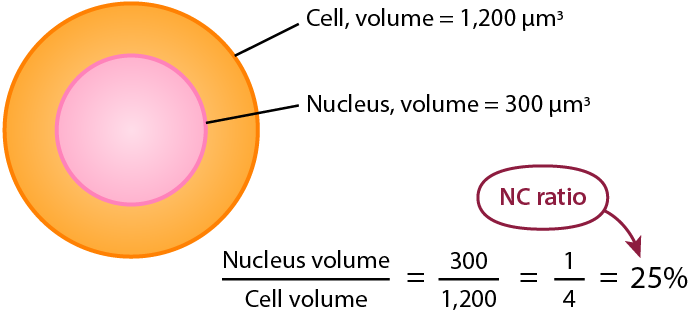
Scientists have been studying cells and their nuclei for decades, trying to figure out why the nuclei in some cells are much larger or smaller than others. Here is what they've found.
- The NC ratio is similar in cells of the same type. All skin cells, for example, can be expected to have a similar NC ratio.
- The NC ratio stays the same as a cell grows and divides. So, as the cell gets bigger, the nucleus also gets proportionally bigger.
- The NC ratio is influenced by the osmotic pressure of molecules inside the cell.
Pressure
Imagine you have an empty balloon. It's elastic, meaning it can be stretched. You take a deep breath and begin to blow air into the balloon. With every breath you take and blow into the balloon it gets a little bigger. Let's think about what's happening here.
The air of your lungs is made up of molecules. These tiny particles are in constant motion. When you inflate the balloon, you're pushing molecules from your lungs into the balloon. The more molecules are in a space of a specific size, the more pressure they create by bouncing off the interior walls of that space. The pressure of molecules bouncing off the inside of the balloon is what makes the balloon bigger when you add more air to it.
When pressure increases inside the balloon, it stretches and gets bigger. But, pressure is also being created by the surface of the balloon. The more the balloon gets bigger and is stretched, the more pressure it applies against the molecules inside it. So, when you add air to a balloon, it only expands until pressure from the balloon equals the pressure from the molecules inside it.
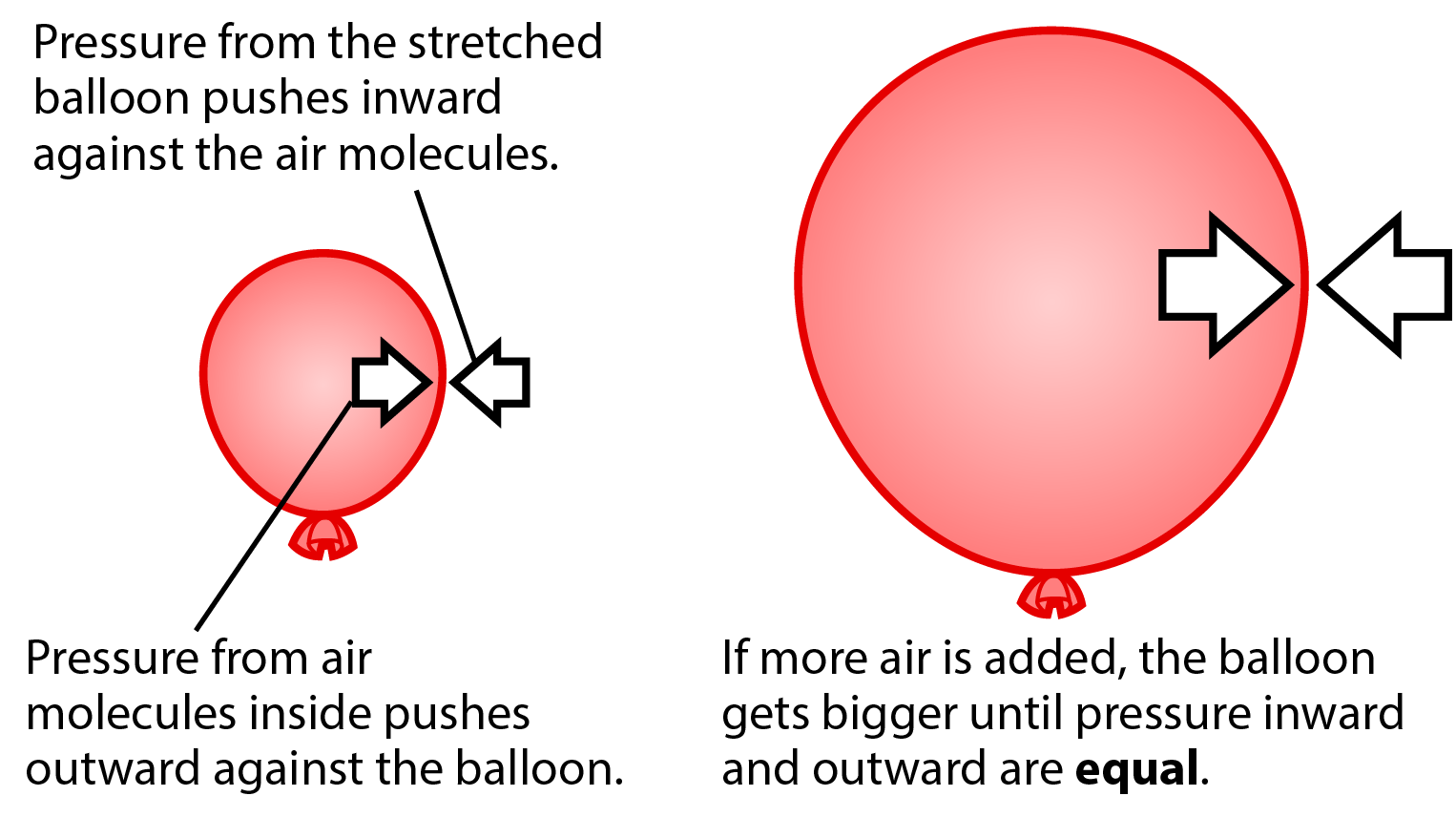
Osmotic Pressure Controls the Cell Size
Pressure in cells is similar to the pressure inside a balloon. Most of the space inside the cell is filled with cytoplasm. Imagine this as a gel-like solution with many different molecules moving around inside. The outside layer that surrounds the entire cell is called the cell membrane.
Molecules moving around inside the cell's cytoplasm create pressure as they bounce against the inner cell membrane. As more molecules are added to the cell, they create more pressure. The pressure exerted by molecules in liquid is called osmotic pressure. This pressure makes the cell get bigger, until the pressure inside the cell is equal to the pressure from the cell membrane surrounding it. In the Cell Simulator section, you can experiment with adding and removing molecules to a cell to see how this impacts the cell size.
To summarize: The size of the cell is based on osmotic pressure created by the total number of molecules inside the cell.
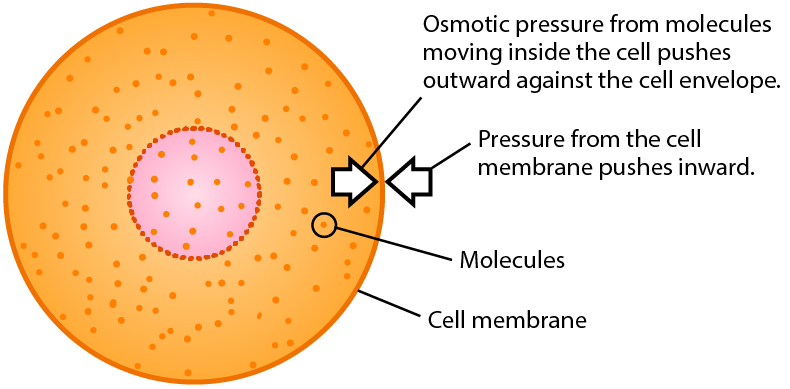
Osmotic Pressure Controls the Nucleus Size
Osmotic pressure also controls the size of the nucleus. Most of the space inside the nucleus is filled with nucleoplasm. Similar to cytoplasm, this is a gel-like solution with many different molecules moving around inside it. The outside layer that surrounds the nucleus is called the nuclear envelope.
Larger molecules moving around inside the cytoplasm and nucleoplasm create pressure as they bounce against the inside of the cell membrane and nuclear envelope. But, these molecules can't cross the nuclear envelope. So, what happens if there are way more molecules inside or outside the nucleus, creating more pressure on one side? The nucleus changes sizes so that the pressure against the nuclear envelope on both sides is balanced. In the Cell Simulator section, you can experiment with pressure, cell size, and nucleus size using a simplified model of a cell.
To summarize: The size of the nucleus is based on a balance of osmotic pressure created by large molecules inside and outside the nucleus that can't cross the nuclear envelope.
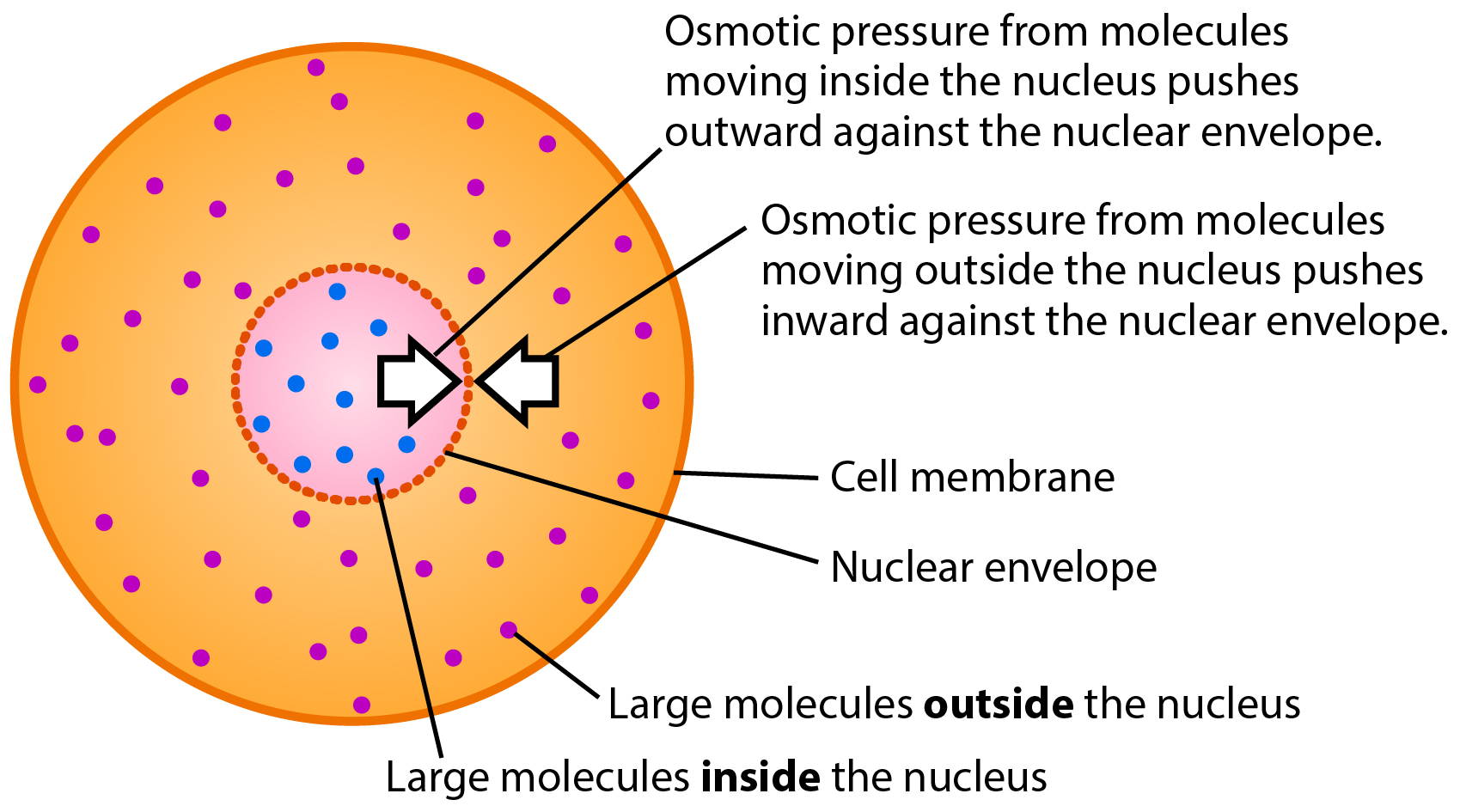
Clues to Disease
Scientists know that specific cell types should have an NC ratio close to a specific size. So, what happens when they find a cell of a certain type that has a much larger or smaller ratio than expected? That is an important clue that there might be something wrong with the cell. Cells with abnormal NC ratios might be something as serious as cancer.
Cancer is one of the leading causes of death worldwide. Doctors describe how advanced a cancer is in grades. The higher the grade number, the more abnormal the cells are. Advanced cancers are more difficult to treat and more likely to spread to other parts of the body. Because of this, it's important for doctors to be able to identify cancer cells early, while the disease is easier to treat. Looking at the NC ratio is one of many tools that doctors can use to identify cancer. In the Explore section, you will learn more about mutations and cancer, and how to tell the difference between a healthy and an unhealthy cell.
The Scientific Method
Every scientist, whether in biology, physics, or medicine, uses the scientific method in their work. The scientific method is a series of steps that scientists use in their research. It includes the following 7 steps: Observation, Question, Hypothesis, Prediction, Testing, Conclusion, and Communication.

Before starting the steps of the scientific method, many scientists actually begin with a literature review. That's when you learn the general information about a topic by reading research articles. If other scientists have already done research on a similar topic, it's a great idea to read about their work and find out what's already been discovered.
The first step of the scientific method, observation, begins when you see, hear, or touch something interesting. The second step involves asking a question, such as how or why something happens.
The third step in the scientific method is developing a hypothesis. This is when you make a guess based on what you already know about what causes something to happen. Next comes the prediction. This is a guess about what you think will happen if you do a specific thing.
The fourth step is making a prediction. This is what you think will happen as a result of the experiment if your hypothesis is true.
The next step is testing. This is where you actually do the experiment and collect data. Scientists also like to repeat experiments, to see if they get similar results. This is called a replication study, and is an important part of the scientific process.
Once you have analyzed the data, you review the results to see how well they support your hypothesis. This process leads you to your conclusion.
Lastly, you need to communicate and share your results with others. That way, other scientists can learn from your work, read about it in their own literature reviews, or try to duplicate your experiment in their own replication studies.
To learn more about the Scientific Method, visit Using the Scientific Method to Solve Mysteries.
The Cell Simulator and the Scientific Method
When scientists want to study something, they often build simplified models to learn how certain things work. The Cell Simulator is a model of the molecules inside a cell. You can use the Cell Simulator section to use the scientific method to run your own experiments about the cell size and NC ratio!
Before starting the scientific method, do some literature review. You're already doing that by reading this Introduction page - well done! You can also visit the Compare Cells section to learn about cells in the human body. Then, visit the Explore section to learn more about growth, mutation, and cancer in cells. If you'd like to read a real scientific article, visit Control of nuclear size by osmotic forces in Schizosaccharomyces pombe, an article about nuclei size written by some of Dr. Biology's colleagues. Have your notebook nearby to take notes.

Finally, the fun part! When the literature review is complete, it's time to run your own experiments with the Cell Simulator. Follow the steps of the scientific method to form your own questions then answer them through experiments by changing the input sliders. Can you spot any patterns in how adding or removing particles changes the size of the cell and nucleus?